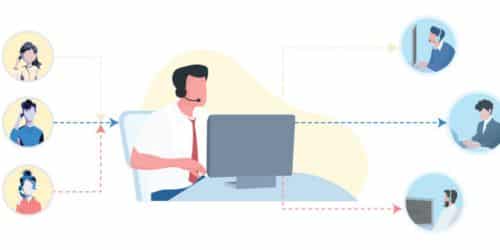Contact Center as a Service (CCaaS) allows for more tailored customer experiences, real-time multichannel communication, and improved agent management and efficiency. While organizations are continually looking for a customer service software solution, many are confused about what Contact Center as a Service is – and why it’s a better option than most on-premises contact centers. We’ll describe CCaaS and discuss how it differs from UCaaS in this article. We’ll also see the best CCaaS providers available.
What is CCaaS?
Contact Center as a Service (CCaaS) is a cloud-based software that provides organizations with access to the provider’s contact center solution via a scalable, pay-as-you-go pricing model in which certain functionalities are provided as needed, a la carte.
CCaaS technology (also known as hosted contact center software) is wholly hosted and maintained in an offsite data center by the supplier, not the end user. This means that CCaaS consumers save money on expensive hardware and in-house IT personnel while benefiting from a solution that adapts to their changing business demands.
IVR and ACD, chat messaging, a range of communication channels, analytics, and other features are offered through the provider via monthly or annual subscriptions.
The Top Advantages of CCaaS Solutions
The convenience and accessibility of CCaaS are just a few of the reasons why so many customer-focused organizations are abandoning traditional on-premises systems and migrating to the cloud.
Here are the most important advantages of CCaaS software.
#1. Scalability and cost savings
The most obvious advantage of using a contact center as a service is the significant cost savings it provides.
Because CCaaS users do not need to buy gear, rent office space, or engage an in-house IT team, they will save thousands of dollars just on beginning costs. Given that corporations pay $2.00 to maintain infrastructure for every $1.00 spent, the savings pile up quickly.
Furthermore, because CCaaS is a “pay-as-you-go” service, organizations avoid paying for unnecessary licensing fees and features. Instead, they buy the features and seats they need right now and then scale up over time.
#2. Team Adaptability
Your customers aren’t the only ones who want the freedom and flexibility that CCaaS delivers.
Because contact center as a service does not bind team members to a single physical location, agents can work from wherever they want, on whatever device they want (including their own). Because CCaaS software instantly syncs conversations across channels and provides real-time notifications, employees can work across time zones seamlessly.
This kind of adaptability offers significant advantages for business owners as well.
Giving agents more flexibility in how and when they work reduces employee turnover, allows firms to draw from a larger pool of talent and access a wider range of skill sets, and even enhances team member productivity by up to 77%.
#3. Improved Workforce Optimization and Increased Productivity
Extra productivity as a result of contact center as a service software stems from more than simply the extra flexibility it allows firms to provide personnel.
Analytics tools provide managers with a birds-eye perspective of how agents and departments spend their time, how long different types of jobs take, and how much time is spent on tasks that could simply be automated.
Even during peak seasons, a more streamlined workforce eliminates the need to hire extra team members. It also stops certain employees from becoming overburdened with jobs and other responsibilities while others go unutilized.
#4. Increased Rates of First Contact Resolution
67% of customers who quit doing business with a company said they would have continued doing so if their problem had been fixed on the first contact. Strong first call resolution rates (FCR) not only reduce customer churn and average call handle time.
CCaaS systems link with CRM applications and provide routing options to connect clients to qualified, available agents. They also ensure that agents have easy, rapid access to internal wiki documents giving answers to common caller queries or customer service scenarios, resulting in much higher FCR rates.
What Are The Features Of CCaaS?
#1. Available Communication Channels
When considering a CCaaS platform, the most crucial factor to consider is the available communication routes.
This does not necessarily imply that the supplier with the most channels is the best option. Instead, be certain that the provider provides the real-time communication channels that your clients prefer.
E-commerce clients, for example, will most certainly prefer to communicate via Internet chat and social network messaging — but not by phone. Healthcare teams, on the other hand, may connect nearly exclusively with their clients by phone and email — but rarely via social media.
This is also where scalability comes into play, as you need to ensure providers provide the channels your organization may require in the future.
#2. Options for Customer Self-Service
Today, nearly 70% of consumers prefer self-service choices to chat with a live representative.
Self-service CCaaS features do more than simply make your consumers happy. They also free up live agents for more difficult support issues, making more outbound calls, or following up on earlier customer contacts.
Customer self-service options include:
- IVR stands for Interactive Voice Response.
- ACD stands for Automatic Call Distribution.
- Customer Callbacks That Are Automated
- Chatbots for Customer Service
#3. Artificial Intelligence and Automation
Given that employees can spend up to 40% of their time on repetitive, manual tasks, business process automation and artificial intelligence (AI) are essential components of any contact center solution. These are the technologies that save time for team members — and customers — by automating basic, rote processes.
With features like automated approvals and status updates, they also lower the risk of human mistake in data collecting and shorten project schedules.
AI and automation features in contact center software should include:
- Speech Recognition and Natural Language Processing (NLP)
- Customer Sentiment Survey
- Customer data collecting and storage that is automated
- Automated call logging
- Follow-up scheduling that is automated
- Agent Assistance in Real Time
#4. Security and customer service
Strong security and support features are required for any business software, including CCaaS.
The following are important security elements to check for:
- Encryption from beginning to conclusion
- Third-party security evaluation
- Compliance with GDPR, HIPAA, PCI, and SOC-2
- ISO-27001 certification
- Guaranteed uptime of at least 99.9% and geographic redundancy
- Data backups and automated updates
- Meeting security/password protection
#5. Interaction Tools for Customers and Agents
CCaaS software should not just make your customers’ lives easier; it should also assist your agents stay organized, finding critical information fast, and keeping track of support conversations.
In addition to the previously listed automated functionalities, features that help agents deliver the greatest service to consumers include:
- Omnichannel routing using a variety of different techniques (skill-based, time-based, hours-based, round-robin, and so on).
- CRM features native to the platform/third-party CRM integrations
- The CTI screen appears.
- Workforce Management Software
- Outbound dialers (such as predictive dialing and progressive dialing)
- Designing a call flow by dragging and dropping
- Notes from the conference call
- Internal wikis that can be searched
- Call and contact scripts
- Call rerouting
- Call waiting, call hold, and call transfer are all options.
- Ring groups and call blasting
#6. APIs and third-party integrations
In addition to compatibility with your present operating systems, Internet browsers, and devices, you must ensure that the CPaaS system is compatible with any third-party software you use.
Browse a provider’s application gallery to get a sense of the platforms for which they have pre-built connections (common tools include Slack, Asana, Salesforce, Zoho CRM, HubSpot, and so on).
In addition, the supplier should provide APIs for developers and have a healthy development community.
#7. Reporting and Analytics
Analytics and reporting solutions provide information on common customer contact reasons, average resolution time, agent activity, and much more.
The following are key CCaaS monitoring features:
- Call recording/transcribing
- Call barge, call whisper, and call monitoring
- Reports that can be customized and pre-made reporting templates
The following are important contact center KPIs and metrics:
- Rates of First Contact Resolution
- Average Contact Duration and Average Contact Handle Time (per agent and overall)
- Price per contact
- Customer satisfaction (CSAT) rate
- Inbound to outbound contact ratio
- Customer Retention Rate and Customer Churn Rate
- Rate of Contact/Call Abandonment
- Dates and Times of Highest Contact Demand
- Analysis of Channel Utilization
Top CCaaS Providers to Consider for Your Business
#1. 8×8
Users of 8×8 get access to 24/7/365 customer assistance from 35 locations across the world, as well as CRM connections with leading customer management tools. It’s no wonder that more than two million corporate users rely on it as a cost-effective and established phone service supplier.
The 8×8 contact center software provides a SLA of 99.999% uptime, scalability, intelligent IVR, workforce management tools, voice analytics, customer experience analytics, and effective CRM connection. It just released Agent Workspace, a new, simpler interface that reduces clutter and personalizes job management to increase representative efficiency.
#2. Talkdesk
Talkdesk describes itself as customer-obsessed and seeks to improve the customer journey. Its contact center software is specifically designed to work in the cloud, and it earns credit for making third-party integration simple via APIs.
#3. NICE inContact
NICE inContact’s primary selling points are self-service and automation. Because of its ease of use, it is a top-of-mind solution for most contact centers, while others may find it deficient in user assistance.
#4. Genesys Cloud
Voice and digital communications capabilities, workforce management tools, artificial intelligence, and analytics are all available with Genesys Cloud CX. It’s most recognized for being incredibly customizable, yet consumers have reported a severe learning curve with this software.
#5. RingCentral
RingCentral focuses on being an agile collaborative solution that enables agents can provide the best possible service across channels by keeping information (on products, customers, etc.) up to current. It’s a fantastic solution for organizations that seek flexibility, while there are occasional setup challenges and bugs that aren’t addressed quickly.
#6. Cisco BroadSoft
Cisco’s purchases of BroadSoft in 2018 and Webex in 2007 aided in the development of what is now known as the Cisco Contact Center Solution (particularly, the cloud-based Webex Contact Center). While this product is not as well-known as the brand’s other offerings, it is still a viable alternative for enterprises looking to shift from on-premise to hosted solutions.
#7. Avaya OneCloud
Avaya provides customers with the option of a voice-only solution, a digital-only solution, or a hybrid of these two alternatives, making it an enticing choice for many organizations. It has a reputation for going above and above to accommodate necessary changes. The main disadvantage is that the team reaction time can be delayed at times.
UCaaS vs CCaaS
The distinction between UCaaS and CCaaS is that UCaaS focuses on connecting team members within a company (internal communication), whereas CCaaS is designed to link customers to support and sales personnel (external communication).
What is UCaaS?
UCaaS (Unified Communications as a Service) is cloud-hosted software that integrates and automatically syncs many business communication channels into a single platform (a “unified” interface).
UCaaS applications, also known as “Unified Cloud Communications,” increase incoming and outgoing communications while reducing the need to transition between platforms on a regular basis.
Despite the fact that the concept was coined in 2014, UCaaS was not widely recognized as a vital communication tool until 2020, when the COVID pandemic caused organizations to migrate to remote work almost overnight.
What is CCaaS?
CCaaS (Contact Center as a Service) is similar to UCaaS in that it offers subscription-based cloud-hosted communication platforms. The fundamental distinction between the two is in the feature set and targeted use case.
Because most UCaaS solutions are used for internal communication, the emphasis is on video conferencing, project management, and collaboration tools. CCaaS, on the other hand, is designed for use by contact centers, therefore its features and functionalities are centered on external communication and tools to improve the customer support experience.
UCaaS vs CCaaS: Differences
Because UCaaS and CCaaS are designed for various use cases, it’s not surprising that their feature sets differ.
Here are a few distinctions to consider before determining which choice is best for your company and consumer interactions.
#1. Video Conferencing
While some CCaaS platforms provide web conferencing, this feature is generally less popular than in UCaaS solutions. This is due to the fact that video conferences are mostly used for internal communication rather than support ticket resolution.
Among the video conferencing capabilities to look for are:
- Screen sharing
- Whiteboarding
- Text messaging
- Raise your hand
- Virtual backdrops
- Group discussions
#2. Self-Service Help
Customer self-service assistance is one area where CCaaS platforms shine.
On UCaaS platforms, you’d be hard pushed to locate even a knowledgebase, while CCaaS solutions go above and beyond with chatbots and AI that can recommend resources to users before they join the support queue.
A CCaaS platform can help customers solve their own problems by providing IVR (Interactive Voice Response), call routing, chatbots with natural language processing, and internal knowledge bases, to name a few features. According to one study, 73% of customers prefer self-service.
#3. Call Distribution
While UCaaS solutions include auto-attendants and rudimentary routing features, they fall short of the comprehensive call routing capabilities provided by a dedicated CCaaS platform.
Certain CCaaS solutions also provide visual call flow editors to help you lay out your call routing strategy.
UCaaS vs CCaaS: Similarities
Now, let’s look at some of the similarities between UCaaS and CCaaS.
#1. Channel Consolidation
UCaaS is concerned with internal communication, but CCaaS is concerned with exterior communication.
Both technologies, however, aim to combine numerous communication channels so that administrators, customers, and team members can access everything from a single dashboard.
#2. Integrations with Third Parties
Large third-party integration galleries are common on UCaaS and CCaaS platforms, letting you use your existing business applications in your SaaS solution interface.
However, there is less overlap in terms of which tools are offered as integrations.
UCaaS platforms frequently prioritize job management and time tracking, whereas CCaaS focuses on CRM tool connections.
#3. Subscriptions by Seat
Most UCaaS and CCaaS platforms have quite similar price structures. The most typical subscription pricing model is per-seat, although there are other solutions of both types that charge a fixed monthly amount with limitless seats accessible.
CCaaS seats often cost $50 to $300 per month, and UCaaS subscriptions typically cost $360 to $480 per year. This indicates that, on average, UCaaS software is less expensive than CCaaS software.
Is Salesforce a CCAAS?
Salesforce Contact Center is a full-fledged CCaaS platform that Salesforce created by merging several of the company’s previous solutions.
How Big Is The CCAAS Market?
In 2022, the global Contact Center as a Service (CCaaS) market was estimated to be worth USD 4.42 billion. The market is expected to expand by 18% over the forecast period, from USD 5.15 billion in 2023 to USD 16.43 billion in 2030.
In Conclusion,
Because of the rise of omnichannel communications and increasingly sophisticated contact center operations, CCaaS (Contact Center as a Service) has grown in popularity. As of 2022, the global CCaaS market accounts for a significant portion of the total SaaS (software as a service) market.
There are numerous CCaaS providers available to businesses, ranging from basic call management apps to more comprehensive multi-channel suites with reporting.
Related Articles
- CALL CENTER: Meaning, Services, Software & Training
- CONTACT CENTER: Meaning, Benefits and Types
- Call Center Job Description: Complete Guide
- VIRTUAL CONTACT CENTER: What It Is, Software and Services






